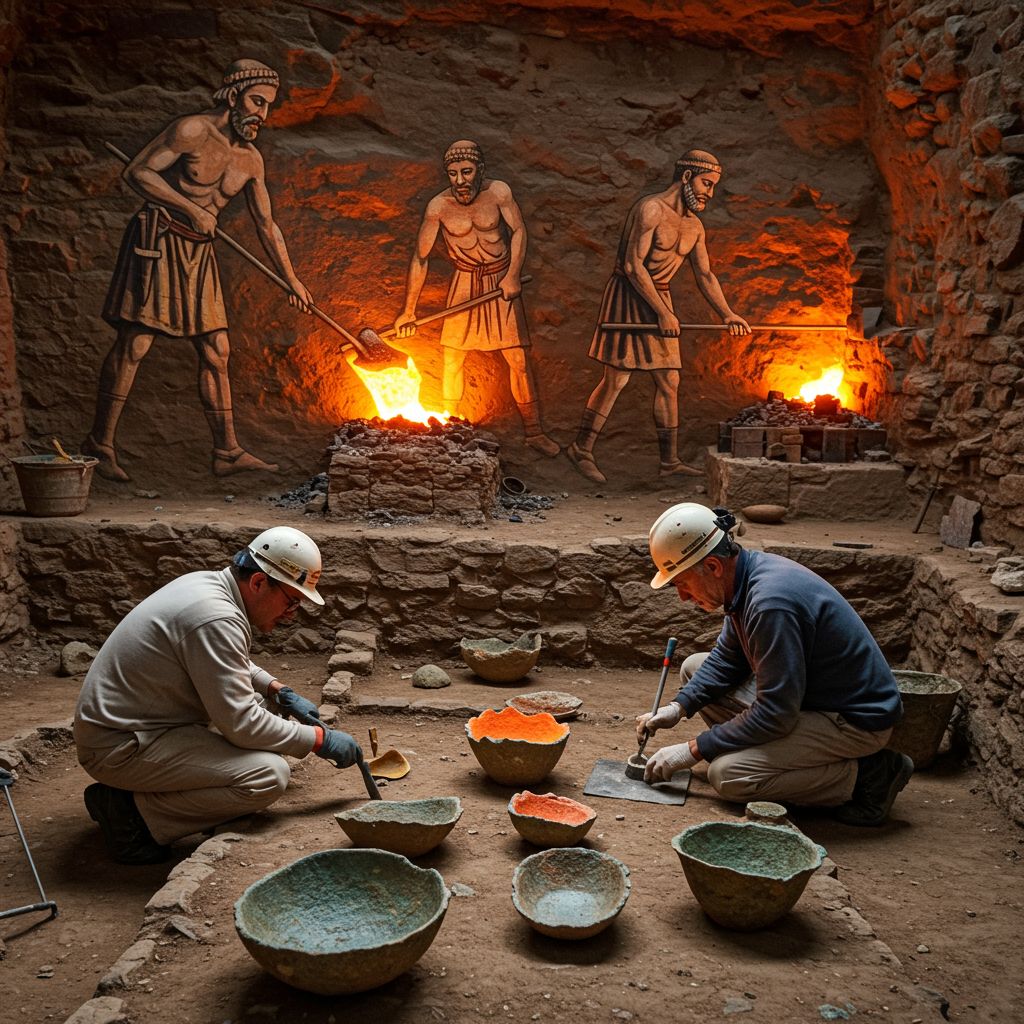For millennia, the precise moment humanity mastered iron extraction remained shrouded in mystery. Now, groundbreaking archaeological research from a 3,000-year-old copper smelting workshop in Georgia, known as Kvemo Bolnisi, is rewriting the narrative of the origins of iron. This pivotal discovery suggests that the development of iron technology wasn’t a sudden invention. Instead, it likely emerged from the skilled hands and experimental minds of ancient copper smelters.
This profound insight challenges long-held assumptions about the transition from the Bronze Age to the Iron Age. It posits that metallurgical innovation was a continuous process, with early metalworkers inadvertently paving the way for the “world’s quintessential industrial metal” through their daily endeavors. The findings offer a compelling glimpse into the incremental steps that led to one of history’s most significant technological leaps.
Unearthing Kvemo Bolnisi: A Misunderstood Legacy
The Kvemo Bolnisi site in southern Georgia dates back to approximately 1200 BCE. Its initial excavation in the 1950s uncovered piles of hematite—an iron oxide mineral—and slag, the waste byproduct of metal production. Based on these discoveries, early archaeologists concluded it was an ancient iron smelting workshop. However, modern scientific re-analysis by Cranfield University paints a completely different picture.
This new research reveals that the workers at Kvemo Bolnisi were not smelting iron at all. Their primary focus was copper production. Crucially, they were using the iron oxide hematite as a “flux.” A flux is a substance added to a furnace to help separate the desired metal (copper) from impurities in the ore, thereby increasing the metal yield. This intentional use of iron oxide in copper metallurgy represents a significant step towards understanding how humans first learned to manipulate iron-bearing materials within a furnace.
The Bronze Age to Iron Age Shift: More Than Just Metal
The transition into the Iron Age marked a widespread adoption of iron, but the metal itself wasn’t entirely new. Earlier iron artifacts, like the famed dagger from King Tutankhamun’s tomb, have been found. However, these rare objects were typically crafted from naturally occurring metallic iron found in meteorites. Such meteoric iron was exceedingly rare and, consequently, often more valuable than gold.
The true revolution came with the development of extractive iron metallurgy. This involved learning to process iron ore, an abundant rock, to extract usable metal. This ability to smelt iron ore into tools, weapons, and infrastructure fundamentally reshaped human societies. It fueled empires like Assyria and Rome. Later, it underpinned the Industrial Revolution, giving rise to railroads and steel-frame buildings. The shift was gradual, spanning hundreds of years, but its impact was transformative.
Global Perspectives on Iron’s Earliest Footprints
While Kvemo Bolnisi offers vital clues about how iron smelting might have emerged, other archaeological discoveries are continually pushing back the timeline for when and where early iron was utilized. Recent excavations in India, particularly in Tamil Nadu, have yielded astonishing results. These findings suggest that smelted iron was in use there as early as 3345 BCE. This potentially predates established iron production timelines by over a millennium.
At sites like Adichchanallur and Sivagalai, archaeologists have uncovered iron objects dated between 5,000 to 5,400 years old. These discoveries indicate an advanced understanding of metallurgy, including ultra-high-carbon steel, developed independently in the Indian subcontinent. This suggests that the origins of iron metallurgy were likely a phenomenon of “parallel developments,” emerging in multiple regions globally rather than from a single source. The presence of sophisticated tools and weapons from such early dates underscores a highly advanced civilization in ancient Tamil Nadu. Researchers are also exploring potential connections between these early South Indian iron makers and the contemporaneous Harappan civilization. They hypothesize a transfer of metallurgical know-how, possibly via maritime routes, influencing local innovation where iron ores were abundant.
Modern Science Illuminates Ancient Practices
Understanding ancient metallurgy is a complex undertaking. Dr. Nathaniel Erb-Satullo, a Visiting Fellow in Archaeological Science at Cranfield University, notes that the lack of written records, iron’s susceptibility to rust, and insufficient research on early production sites make the search for iron’s origins challenging. This is where advanced scientific techniques become indispensable.
Researchers employed methods such as scanning electron microscopy (SEM) to analyze the chemistry, mineralogy, and microstructure of metallurgical remains from Kvemo Bolnisi. This allowed them to precisely identify the materials and processes involved. Similarly, the revolutionary use of Accelerator Mass Spectrometry (AMS) for radiocarbon dating charcoal samples in Tamil Nadu has provided unprecedented chronological precision. These modern tools allow archaeologists to “get into the minds of ancient materials scientists,” as Erb-Satullo eloquently puts it. They enable deep insights into past technologies, often derived from seemingly “mundane waste material” like slag.
Beyond Metallurgy: Iron Slag and Earth’s Magnetic Past
The analysis of ancient metallurgical waste extends beyond understanding metal production. Surprisingly, materials like slag can also offer critical data for other scientific fields. For instance, archaeomagnetism, a relatively new technique, uses magnetic particles within archaeological materials. These particles, when heated and then cooled, align with Earth’s magnetic field at that specific time. This process creates a “snapshot” of the field’s direction and intensity.
This technique led to the discovery of the Levantine Iron Age Anomaly (LIAA). This anomaly represents a period of intensely strong magnetic field spikes in the Middle East from approximately 1100 to 550 B.C. Artifacts like copper slag unearthed in Jordan, dating back 3,000 years, provided the crucial evidence. These findings are vital for understanding Earth’s geodynamo. They help scientists predict future fluctuations in our planet’s protective magnetic shield. Thus, the very “funny-looking rock” that reveals origins of iron can also unlock secrets about Earth’s core.
The Power of Experimentation: A Defining Step
The Kvemo Bolnisi discovery reinforces a long-discussed theory: that iron smelting was sparked by copper smelters. These ancient metalworkers, experimenting with various iron-bearing materials in their furnaces, gradually understood iron oxide as a distinct material. Their curiosity and repeated experimentation within the high-temperature environment of the copper furnace were crucial.
Such experimentation provided the foundation for eventually developing dedicated iron smelting techniques. This highlights a fundamental aspect of human technological progress: innovation often arises from adapting existing tools and processes. The metalworkers of Kvemo Bolnisi weren’t consciously aiming to invent iron. Yet, their practical work with flux led directly to a monumental shift in human history. This continuous exploration of material properties shaped the destiny of civilizations.
Frequently Asked Questions
How did copper smelters accidentally pave the way for iron production?
Copper smelters at sites like Kvemo Bolnisi used iron oxide minerals, specifically hematite, as a “flux.” This substance helped separate copper from impurities in the ore, increasing its yield. Through repeated experimentation with iron-rich materials in their high-temperature furnaces, these ancient metalworkers began to understand iron oxide’s unique properties. This unintentional manipulation and observation of iron-bearing materials within the smelting process were crucial steps. They provided the foundational knowledge and experience that eventually led to the intentional extraction and smelting of iron ore.
Which archaeological sites offer the earliest evidence of iron metallurgy?
While the Kvemo Bolnisi site in Georgia (c. 1200 BCE) sheds light on the mechanism of iron’s invention, some of the absolute earliest evidence of smelted iron comes from the Indian subcontinent. Recent research from Tamil Nadu, India, has dated iron objects at sites like Adichchanallur and Sivagalai to between 3345 BCE and 2953 BCE. These findings suggest independent origins of iron metallurgy in India, potentially predating established timelines by over a thousand years. Other significant early sites include Malhar in India’s Gangetic Plain (1800-1000 BCE) and regions in present-day Turkey (13th Century BC).
Why is the re-evaluation of sites like Kvemo Bolnisi critical for understanding human technological advancement?
Re-evaluating sites like Kvemo Bolnisi using modern scientific techniques is critical because it challenges and refines our understanding of ancient technological evolution. It moves beyond simplistic “discovery” narratives to reveal the complex, incremental processes behind major innovations. This specific re-evaluation highlights the role of experimentation and adaptation in pre-existing industries (copper smelting). It demonstrates how innovation often emerges from practical problem-solving. This nuanced understanding provides valuable insights into human ingenuity. It also emphasizes the importance of revisiting historical assumptions with advanced scientific methods to truly grasp our technological past.
The Enduring Legacy of Ancient Artisans
The discovery at Kvemo Bolnisi, coupled with other global findings, paints a more intricate and fascinating picture of the origins of iron. It underscores that technological breakthroughs are rarely the work of a single genius. Instead, they are often the culmination of generations of practical knowledge, curious experimentation, and incremental adaptations. The metalworkers of Kvemo Bolnisi, alongside their counterparts across the globe, laid the groundwork for a metal that would shape human history for millennia. Their legacy continues to be revealed through the very “funny-looking rocks” they left behind. Ongoing archaeological and scientific investigations promise to uncover even more secrets from humanity’s past.




